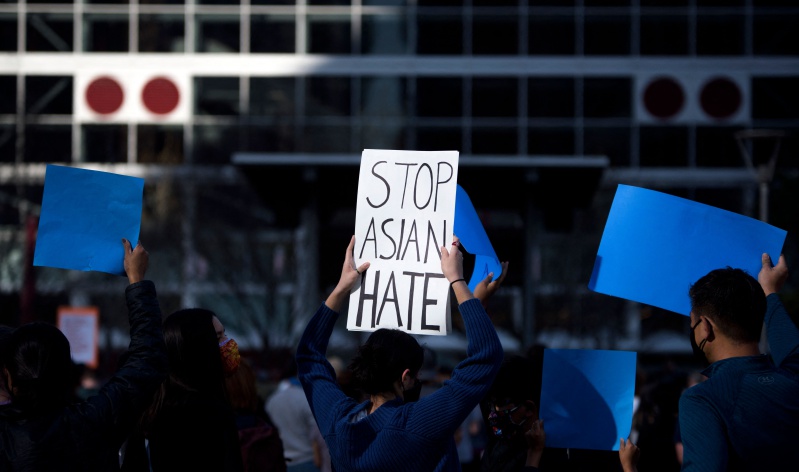
Scholars discuss ways to recognize and address anti-AAPI sentiment and policies.
Xiaojie Tan. Daoyou Feng. Hyun Jung Grant. Soon Chung Park. Suncha Kim. Yong Ae Yue. Rong Xin Liao. Xiao Zhen Xie. Vilma Kari. These are only a few of the many victims of the recent surge in hate and violence against the Asian American and Pacific Islander (AAPI) community.
In the past year, the number of reported hate crimes in the United States have decreased by roughly 7 percent. The incidences of reported hate crimes against the AAPI community, however, have increased by 149 percent. According to Stop AAPI Hate, an organization dedicated to tracking xenophobia against the AAPI community, 3,795 hate crimes against AAPI members were reported in 2020. This number is just a floor, not a ceiling, for the number of racist incidents against the AAPI community in the past year.
Prejudice against the AAPI community does not only manifest in violence. At the start of the pandemic, anti-Asian American rhetoric was linked to discussions of COVID-19. Specifically, early use of the term “Chinese virus” has been associated with anti-AAPI sentiment.
But animus toward the AAPI community is not just a response to the COVID-19 pandemic. The United States has a long and often overlooked history of racism against AAPI individuals. Anti-Asian xenophobia in the United States has been linked to public health and immigration policies since the nineteenth century. In 1882, motivated by a fear of foreign disease, Congress passed the Chinese Exclusion Act, becoming the first immigration law to target an entire ethnic group. In the 1920s, the fear of immigrant diseases led to immigration restrictions on Ellis Island.
The influence of anti-Asian bias reaches beyond public health and immigration policy. The murder of Vincent Chin still weighs heavily on the minds of many AAPIs and allies. In 1982, Vincent Chin was murdered by two white men. Chin was an innocent man who was attacked because of his race, yet neither attacker served any time in jail. The nationwide protests following Chin’s murder were seen as a turning point in AAPI history, but, as recent events have shown, the fight against anti-AAPI racism is far from over.
One barrier to eradicating AAPI hate is the difficulty of identifying anti-AAPI bias. State and federal law protects against hate crimes and other forms of racial discrimination, but experts argue that proving a racist motive against AAPIs is especially difficult, partly because racism against AAPIs often intersects with other forms of discrimination such as sexism or classism.
Racial and non-racial motives are not mutually exclusive, but the intersectional motivations behind many acts against the AAPI community make it more difficult to recognize AAPI hate as such. The 2021 Atlanta shootings are a tragic example of the intersectionality of anti-AAPI bias. The gunman specifically targeted Asian businesses and six out of the eight victims were Asian women. The police and the media, however, were reticent to label the shootings as a hate crime because the gunman claimed that he acted as a result of his “sex addiction.” Focusing on the gunman’s sexual motivation distracts from the racist nature of the crime. So far, prosecutors have not added a hate-crime offense to the charges.
Another barrier to addressing anti-AAPI bias, and racism more generally, is the difficulty in collecting accurate data on discrimination and hate crimes. Under the Hate Crimes Prevention Act of 2009, “hate crime” is defined as the infliction or attempted infliction of bodily injury when “motivated by … race, color, religion, national origin, gender, sexual orientation, gender identity, or disability.” At the state level, however, the definition of hate crime is varied, making it difficult to collect national data. Many hate crimes also remain unreported, either because the victim chooses not to notify the authorities, or because the incident is not recognized as a hate crime under the law.
Over the past few months, there have been renewed efforts to recognize and combat AAPI hate. In January, President Joseph R. Biden released a memorandum condemning racism against the AAPI community. On April 22, the U.S. Senate approved the COVID-19 Hate Crimes Act, which aims to expedite the review of COVID-19 hate crimes, particularly against AAPIs.
Even with these measures, greater awareness and a clearer understanding of AAPI racism and how it affects people and institutions today is of paramount importance. This week’s Saturday Seminar focuses on the relationship between regulation and anti-AAPI sentiment in the United States.
AAPI Awareness
- In an article in the Washington and Lee Journal of Civil Rights and Social Justice, Vinay Harpalani, professor of law at the University of New Mexico School of Law, reflects on recent hate crimes against Asian American individuals to examine the diversity of the Asian American community. Harpalani reviews the legacy of anti-Asian racism in the United States and the arbitrary racial constructs classifying immigrants from Asia and Asian Americans as non-white and inherently foreign. Harpalani argues that the current political and regulatory discourse, which is rooted in stereotypes, ignores the diversity among the Asian American community. Harpalani concludes that the term “Asian American” leads to the erasure of certain groups but is better than the term “Asian” alone, which leads to perceptions of foreignness.
- In an article published in Daedalus, Jennifer Lee of Columbia University explores the history of AAPIs in the United States and tracks the shift from being labeled as the “yellow peril” to the “model minority.” She observes that, due to their “model minority” status, AAPIs are often wedged between other racial minorities and the white majority. Lee explores the ways in which the AAPI community has both been victimized by and complicit in the model minority stereotype. She claims that the COVID-19 pandemic has presented the AAPI community with an opportunity to examine critically its role in American society and to “reimagine what racial justice and multiracial coalitions could look like.”
AAPIs in Schools
- AAPI students face “peer racial violence” in school, ranging from verbal harassment to physical assaults, William Y. Chin of Lewis and Clark Law School contends in The Scholar. According to Chin, perpetrators target AAPI students, and school officials do not intervene adequately due to three inaccurate stereotypes: the “model minority” stereotype, the “silent minority” stereotype, and the “perpetual foreigner” stereotype. To counter this peer racial violence, Chin calls for cultural competency and anti-racism training in schools, written anti-racial harassment policies, and better outreach programs for AAPI families. In addition, he recommends establishing a legal duty for schools to protect AAPI students from attacks. Finally, Chin encourages parents of victims to sue the attackers and schools that fail to implement protections.
- Affirmative action in higher education is designed to increase admissions of students from underrepresented racial groups. In an article in the UCLA Law Review, Kimberly West-Faulcon of Loyola Law School criticizes the claim that affirmative action causes racial discrimination against AAPI students in college admissions. West-Faulcon argues that caps on AAPI admissions, which she refers to as the “Asian penalty,” are not caused by affirmative action-enforced minimums for African Americans, which she refers to as the “Black bonus.” West-Faulcon contends that admissions rates for AAPI students should be compared to white students, not African American or Latino students, to determine whether an Asian penalty exists. West-Faulcon warns that focusing on the relationship between an Asian penalty and a Black bonus distracts from the real issue: whether AAPI students are disadvantaged in college admissions at all.
Impact of COVID-19 on the AAPI Community
- The start of the COVID-19 pandemic triggered an “immediate increase in racist Google searches and Twitter posts targeted at Asians,” Runjing Lu of the University of Alberta and Sophie Yanying Sheng of the University of California, San Diego argue in a paper released by 21st Century China Center. Although the increase in animosity toward Asian Americans is partially attributed to the connection between COVID-19 and its origins in China, Lu and Sheng contend that tweets by former President Donald J. Trump also significantly contributed to the increase in racially charged animus. In addition, because many of the online posts targeting Asians following the start of the pandemic in the United States did not explicitly mention COVID-19, Lu and Sheng suggest that “pandemic-induced racial animus extends to broader topics and may persist beyond the duration of the pandemic.”
- In a Northwestern Journal of Law and Social Policy article, Peter H. Huang of the University of Colorado Law School examines how negative reactions to the pandemic have exacerbated anti-AAPI racism in the United States. Huang claims that pandemic-related anxiety may promote xenophobia, which could explain why the AAPI community has been targeted over the past year. Huang advocates the adoption of policies, such as providing monthly financial assistance to individuals, to address the underlying suffering caused by the current and future pandemics. Huang argues that adopting such policies to reduce suffering during pandemics will mitigate the risk of backlash against the AAPI community and other vulnerable populations.
The Saturday Seminar is a weekly feature that aims to put into written form the kind of content that would be conveyed in a live seminar involving regulatory experts. Each week, The Regulatory Review publishes a brief overview of a selected regulatory topic and then distills recent research and scholarly writing on that topic.



